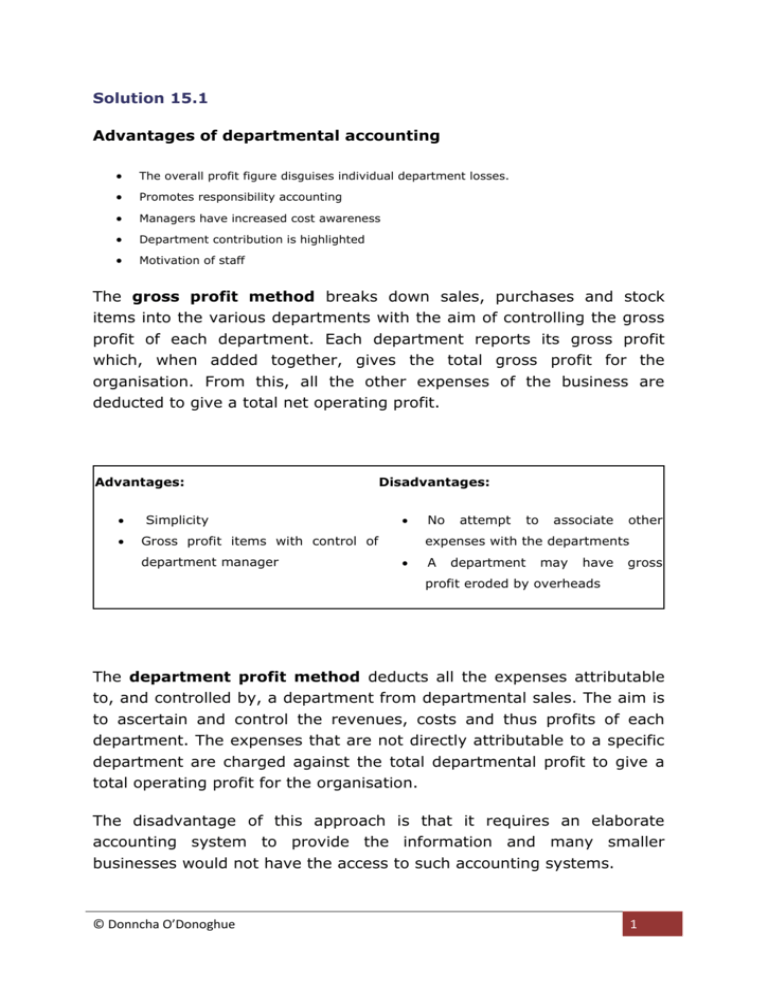Solution 15.1 Advantages of departmental accounting The gross
advertisement

Solution 15.1 Advantages of departmental accounting The overall profit figure disguises individual department losses. Promotes responsibility accounting Managers have increased cost awareness Department contribution is highlighted Motivation of staff The gross profit method breaks down sales, purchases and stock items into the various departments with the aim of controlling the gross profit of each department. Each department reports its gross profit which, when added together, gives the total gross profit for the organisation. From this, all the other expenses of the business are deducted to give a total net operating profit. Advantages: Simplicity Disadvantages: Gross profit items with control of department manager No attempt to associate other expenses with the departments A department may have gross profit eroded by overheads The department profit method deducts all the expenses attributable to, and controlled by, a department from departmental sales. The aim is to ascertain and control the revenues, costs and thus profits of each department. The expenses that are not directly attributable to a specific department are charged against the total departmental profit to give a total operating profit for the organisation. The disadvantage of this approach is that it requires an elaborate accounting system to provide the information and many smaller businesses would not have the access to such accounting systems. © Donncha O’Donoghue 1 Advantages: More Disadvantages: information on department elaborate accounting system performance Requires Only controllable costs included in department profit Form of responsibility accounting Fairer Motivation improved In the net profit method all the expenses of the business are charged to each revenue producing department whether they are directly related and controlled by that department or not. Advantages: Disadvantages: Profit reflects benefit from shared Needs elaborate accounting system expenses Method of apportionment can be Focuses on net profit rather than gross profit of each department arbitrary and subjective Departments contributing to the organisation may now show a net loss Incorrect decision making (shutdown) Managers may be demotivated by inclusion of uncontrollable costs Solution 15.2 Cost apportionment represents the assignment of a cost to a number of departments or cost centres. Cost apportionment is necessary when ‘shared’ costs of an organization need to be divided among all the departments that incur a benefit from © Donncha O’Donoghue 2 that cost. Depreciation of equipment Value of equipment General managers salary Sales volume Head office administration costs Number employees Depreciation of premises Area / floor space Rent and rates Area / floor space Advertising Sales revenue Accounting Total cost of Solution 15.3 Departmental Income Statement Based on Net Profit Method Accommodation Sales Restaurant Bar Total € € € € 500,000 250,000 200,000 950,000 0 Less cost of sales 4,000 3,000 7,000 120,000 90,000 210,000 3,500 2,000 5,500 ______ 120,500 91,000 211,500 500,000 129,500 109,000 738,500 117,500 80,120 32,500 230,120 29,500 14,500 6,000 50,000 147,000 94,620 38,500 280,120 Opening stock Purchases closing stock Gross profit Less direct expenses Wages Repairs and main Less Indirect expenses © Donncha O’Donoghue 3 Electricity & power 60.00% 27,000 35% 15,750 5.00% 2,250 45,000 Rent & Rates 60.00% 73,200 30% 36,600 10.00% 12,200 122,000 Depreciation 60.00% 36,000 30% 18,000 10.00% 6,000 60,000 Postage & telephone 52.63% 9,211 26.32% 4,605 21.05% 3,684 17,500 Advertising 52.63% 23,684 26.32% 11,842 21.05% 9,474 45,000 Laundry & cleaning 52.63% 4,737 26.32% 2,368 21.05% 1,895 9,000 Administration 52.63% 36,842 26.32% 18,421 21.05% 14,737 70,000 52.63% 210,674 26.32% 107,587 21.05% 50,239 368,500 20,261 89,880 Net Profit / (Loss) 142,326 (72,707) The main disadvantages of the net profit method are: Needs elaborate accounting system Method of apportionment can be arbitrary and subjective Departments contributing to the organisation may now show a net loss Incorrect decision making (shutdown) Managers may be demotivated by inclusion of uncontrollable costs Solution 15.4 Departmental Income Statement (Departmental profit method) Sales Cinema Restaurant Bowling Total €'000 €'000 €'000 €'000 2,100 3,000 1,200 Less cost of sales Opening stock 6,300 0 100 120 80 300 1,050 1,200 700 2,950 80 105 65 250 Cost of sales 1,070 1,215 715 3,000 Gross profit 1,030 1,785 485 3,300 200 150 130 480 50 40 20 110 250 190 150 590 Purchases closing stock Less direct expenses Wages Repairs and main © Donncha O’Donoghue 4 Departmental profit 780 1,595 335 2,710 Less Indirect expenses Rent 800 Light and heat 150 Insurance 200 Admin. And accounting 80 Personnel 200 Head office costs 120 General expenses 50 Depreciation 10 Canteen costs 20 Indirect expenses 1,630 Net Profit 1,080 Departmental Income Statement (Net Profit method) Cinema Restaurant €'000 €'000 2,100 Sales 3,000 Bowling Total €'000 €'000 1,200 6,300 0 Less cost of sales Opening stock Purchases closing stock Gross profit 100 120 80 300 1,050 1,200 700 2,950 80 105 65 250 1,070 1,215 715 3,000 1,030 1,785 485 3,300 200 150 130 480 50 40 20 110 Less direct expenses Wages Repairs and main Less Indirect expenses Rent 33.33% 266.6 40% 320.0 26.67% 213.4 800 Light and heat 33.33% 50.0 40% 60.0 26.67% 40.0 150 Insurance 33.33% 66.7 40% 80.0 26.67% 53.3 200 Admin & accounting 50% 40.0 37.50% 30.0 12.50% 10.0 80 Personnel 50% 100.0 37.50% 75.0 12.50% 25.0 200 33.33% 40.0 47.62% 57.1 19.05% 22.9 120 Head office costs © Donncha O’Donoghue 5 General expenses 33.33% 16.7 47.62% 23.8 19.05% 9.5 50 Depreciation 33.33% 3.3 47.62% 4.8 19.05% 1.9 10 50% 10.0 37.50% 7.5 12.50% 2.5 20 Canteen costs Net Profit 843.289 848.216 528.495 2,220 186.711 936.784 -43.495 1,080 Appropriateness of some of the apportionment methods – key points Can be a very subjective process. The best way to apportion costs is on the basis of the greatest benefit- i.e. the department who gets the greatest benefit from the cost must take the greatest amount of the cost. This makes the apportionment process very time consuming and expensive. More appropriate basis may be for depreciation to be based on the book value of assets in each department. Insurance of the assets based on the book value of the assets. © Donncha O’Donoghue 6






